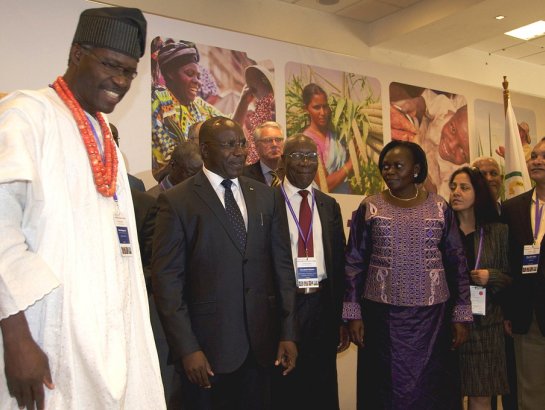Global policymakers, meeting in Kigali earlier this month at the Second Global Conference on Biofortification, committed to making biofortified nutritious foods more widely available in order to improve nutrition and health for millions of people around the world. These foods include staples, such as bean, sweet potato, cassava, maize, pearl millet, rice, and wheat, that people rely upon for sustenance globally.
Scientists from CGIAR, a global agricultural research partnership, have developed new varieties of these foods that are not only high yielding, but also more nutritious: they contain higher amounts of vitamin A, zinc, and iron that are essential to good health.
HarvestPlus, a CGIAR program to improve nutrition and public health that organized the conference, announced that biofortified nutritious food crops have already reached more than one million farmers globally. By forging new partnerships, it aims to reach more than 100 million people suffering from malnutrition with biofortified crops by 2018.
To support this goal, the CGIAR announced that its research centers will start improving mineral and vitamin content across all conventional breeding programs for food crops. Two of these centers, IRRI and CIMMYT, were instrumental in developing high yielding rice and wheat varieties as part of the Green Revolution in the 1960s. The new varieties were credited with saving hundreds of millions of lives from famine.
The full lineup of CGIAR centers, and the crops they are working on, are as follows: CIAT (iron beans and vitamin A cassava), CIMMYT (nutritious maize and zinc wheat), CIP (vitamin A orange sweet potato), ICARDA (iron, zinc and selenium lentils), ICRISAT (iron and zinc pearl millet and sorghum), IITA (vitamin A cassava and maize), and IRRI (zinc rice).
“At this conference the CGIAR Consortium and its members, the CGIAR Research Centers, have committed to make breeding for mineral and vitamin traits in their regular food crop development programs the norm. Agriculture is re-affirming its core purpose: to provide people, particularly those in greater need, with the nutritious foods necessary to lead healthier and more productive lives.” said Frank Rijsberman, CEO of the CGIAR Consortium.
M. S. Swaminathan, Father of India’s Green Revolution, called for an International Year of Underutilized and Biofortified Crops. “If this comes through, biofortification will receive further international recognition as an important approach to overcoming hidden hunger and malnutrition,” he said. He also announced that a “garden” of biofortified crops and varieties would be established at his research foundation in India to serve as an important resource for developing countries that wish to develop more nutritious food crops.
Chris Elias, President of the Global Development Program at the Bill & Melinda Gates Foundation noted: “With biofortification, we now have an important new tool to add to the micronutrient intervention package, complementing supplementation, fortification, and nutrition education. The scientific evidence of [biofortification’s] efficacy is compelling.”
Ministerial delegations from Rwanda, Uganda, and Nigeria, all countries where biofortified nutritious crops have been released, said that these crops are being fully integrated into their agriculture and nutrition planning. In his remarks, Akinwumi Adesina, Nigeria’s Minister of Agriculture and Rural Development, reinforced this: “We need to build strong political will behind nutrient-rich crops, using top political leaders as nutrition champions. This is where the African Union and the Global Panel on Agriculture and Food Systems for Nutrition can play major roles.”
Peter Malnak, USAID Mission Director for Rwanda said: “It is clear that biofortified crops are front and center among the array of new and improved technologies that Feed the Future, through USAID, is working with national, NGO, and private sector partners to promote. Whether it is iron beans here in Rwanda, or orange [vitamin A] maize in Zambia, we are working with HarvestPlus to help ensure that the incredible progress of its research now becomes mainstreamed in the food systems that underpin improved nutrition, especially for those most at risk.”
A range of other partners from both the public and private sector also asserted or re-affirmed their commitment to reducing malnutrition through food-based approaches such as biofortification, including the World Food Programme, the UK Department for International Development, World Vision, and the CSO-SUN Alliance of Zambia.
Nearly one in three people globally suffers from a lack of essential vitamins and minerals in their diet, a condition known as hidden hunger. This increases the risk of stunting, anemia, blindness, infectious diseases, and even death. Women and children are especially vulnerable. In light of this grave reality, conference participants lent their voices to a ‘Kigali Declaration on Biofortified Nutritious Foods’ that will pave the way for this new approach to reduce hidden hunger and improve public health through familiar foods that people eat every day.
In a special video address to participants, Copenhagen Consensus Director, Dr. Bjorn Lomborg, reminded participants that “biofortification is one of the best ways to spend public money…every $1 invested in biofortification yields about $17 of good in the world.”
The conference, ‘Getting Nutritious Foods to People,’ organized in conjunction with the Government of Rwanda, was held in Kigali from March 31- April 2. It attracted more than 300 high-level policymakers and practitioners from different sectors. Representing the host government, The Right Honorable Pierre Damien Habumuremyi, Prime Minister of the Republic of Rwanda, provided the opening keynote. The Honorable Agnes Kalibata, Rwanda Minister of Agriculture and Animal Resources, and the Honorable Agnes Binagwaho, Rwanda Minister of Health, also addressed the conference.
Resources
• View or download conference presentations, videos, and photos,
• Learn more about the Global Panel on Agriculture and Food Systems for Nutrition, and the Copenhagen Consensus Center
